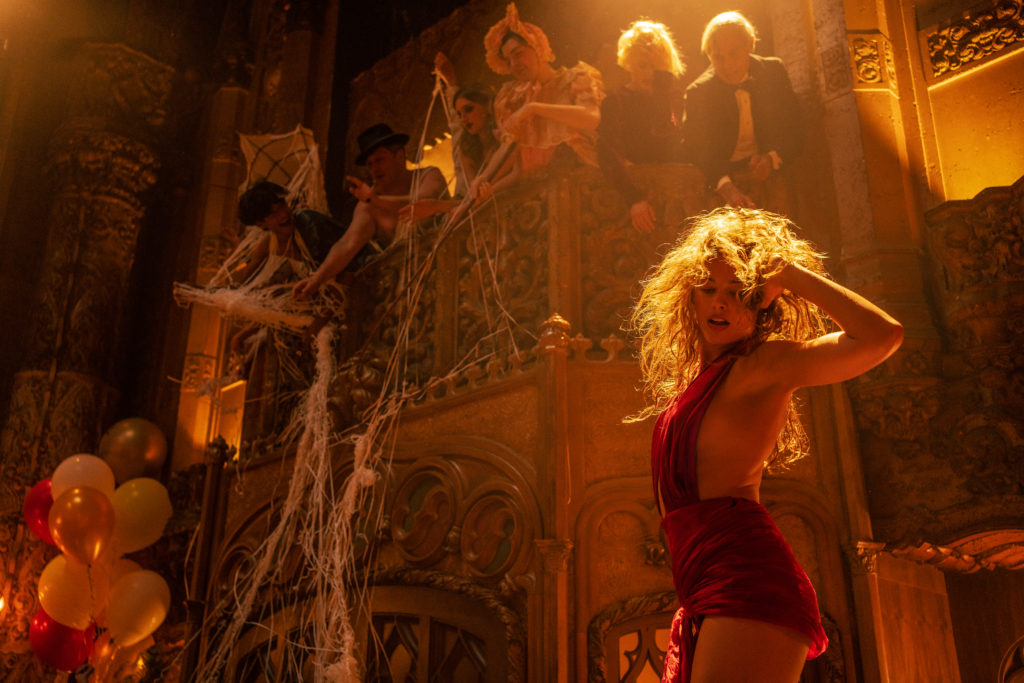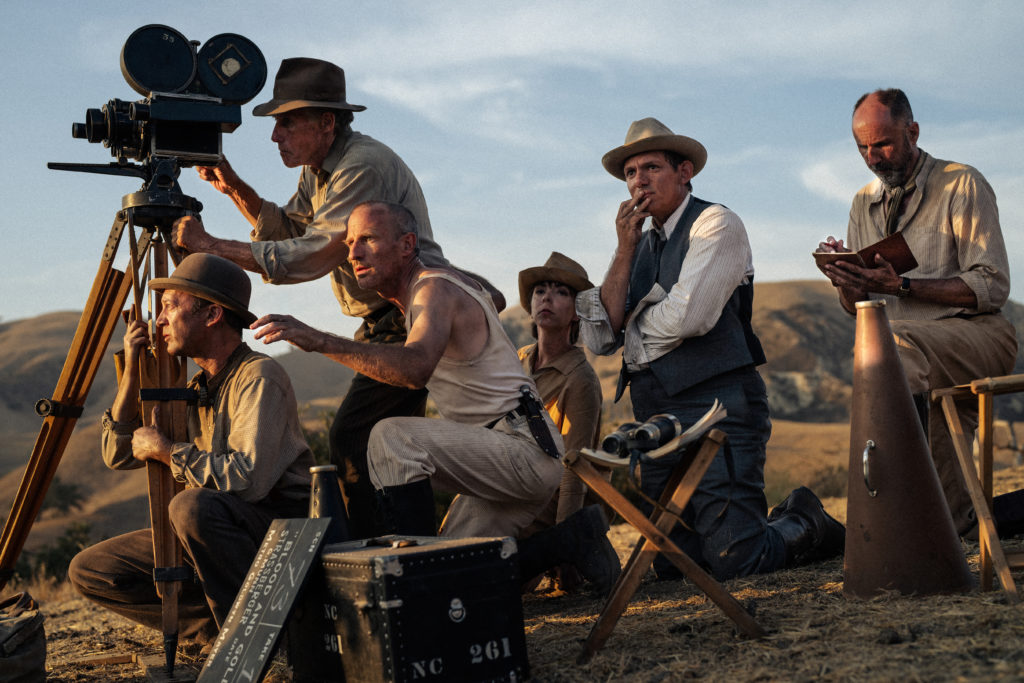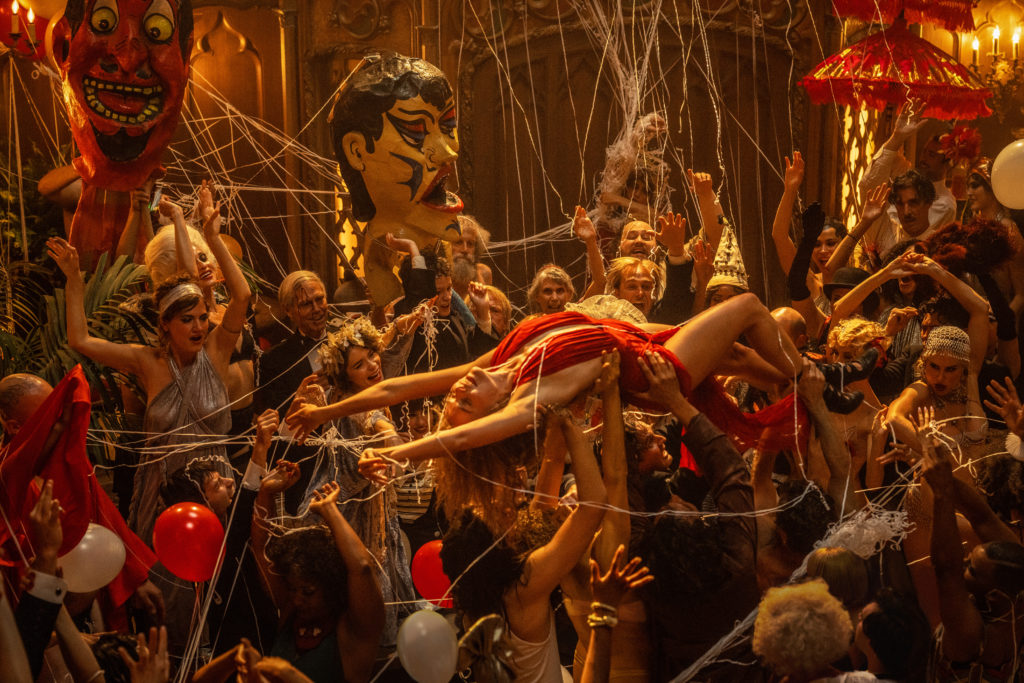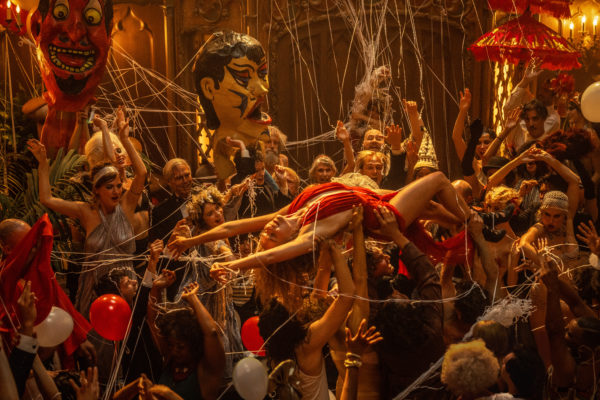In theaters tomorrow, December 23, from Paramount Pictures, Babylon sees La La Land director Damien Chazelle offer a new take on the mythological appeal of Hollywood—this time, turning the lens on a wide-ranging group of filmmakers, criminals, and degenerate partiers who witnessed first-hand the industry’s transition from silents to sound films. Boxoffice Pro spoke to costume designer Mary Zophres—regular collaborator with Chazelle and the Coen Brothers—on taking a fresh approach to ’20s fashion.
You’ve worked with Chazelle before–at what point did you join Babylon? Doing costume design for a movie about the formative years of Hollywood must be a dream job.
I got a text from Olivia [Hamilton], who’s Damien’s wife and producing partner on this film, and she said “Damien wants to send you a script.” I was grateful for being contacted by them, because I never take for granted that I’m going to be hired again, with any filmmaker that I’ve worked with. I read the script in the spring of 2019. First of all, it’s very naughty. I was a little shocked. But the characters and the story were so moving to me. Particularly Manny [Diego Calva] and Jack [Brad Pitt] and Nellie [Margot Robbie]–but everybody has such a heartfelt arc within the setting of this bombastic, energized [script]. And it read the way you see it at the movies. The way Damien writes is so kinetic. The epic nature, and it’s totally original. There are all these characters, and it’s early Hollywood–it’s an awesome, dream-come-true kind of job. And so of course I was on board immediately; I’m super happy and grateful to be asked to participate as a designer on the film.
The original idea was to start prepping in early 2020. We started to do some research. I reached out to Damien very early on and said, “Damien!”–like I said, my initial reaction was sort of shocked, because this is really racy. And he started laughing and said, “It’s actually something I’ve been thinking about for a very long time. And these are the things that I researched before I wrote the script.” And so he gave me a list of books and films that he watched that were either about early Hollywood or were early silent films. I’d see several silent films in film class, but in all honestly, the only silent film that I’ve watched since college is [D.W. Griffith’s] Intolerance, because it’s one of my favorites.
I started doing some reading and watching the films that were on his list, and then the pandemic hit, which gave us even more time to delve into the research. He really wanted to challenge [me and Production designer Florencia Martin] to try to make it not look like another movie about the 1920s. He wanted to avoid all the tropes that are used–and were maybe very useful in telling those stories, but not for telling this story. Part of the challenge was: Let’s find photographs. Let’s find research. Let’s find inspiration from the ‘20s, but you can’t identify them as being from the ‘20s. At first that was really challenging, but once you [keep scratching] at research you can really find where your niche is. We were finding more and more and more and more and more evidence, that it became clear to me: We’ve been watching a lot of Hollywood movies [that have] been based on one particular look from the 1920s, but there’s this whole other world that really hasn’t been explored. That’s indicative of the script that he wrote. And so that’s our launchpad. Some of [the research material came from] early Hollywood film sets. We [found] pictures and portraits of people that were working class, underbelly. There were a handful of books that had letters talking about Hollywood parties. I was like, “Okay, it really was like this. It’s just that we haven’t really seen it portrayed in film yet.
If we could find something that you couldn’t automatically identify as ‘20s, but was from the ‘20s, oftentimes that became an inspiration. Then it was breaking down the script [by character and character arc]. Then the pandemic hit, so we were sharing, digitally, these inspirational ideas. Then we started [sharing inspiration ideas for individual scenes]: This is the Don Wallach party. This is the pool party. This is the inspiration for the battle. This is the inspiration for Singin’ in the Rain. This is the inspiration for Nellie’s silent film set. This is the inspiration for Nellie’s first sound set. We had a lot of groundwork. It was the scaffolding for all of us. Once we started our formal prep, [the research and planning] was like a launchpad, and we all just took off like rockets.

I wanted to bring up those party scenes, because they are so spectacular in terms of costuming. You can look at any background extra, and they’re dressed in something interesting. It works so well on the big screen, whereas if you were watching Babylon on your TV you wouldn’t catch all that detail.
Every time an extra comes in the door, they get a backstory. That’s how I instruct my crew, because I like to be there for all the background fittings, but I don’t actually fit every single background [actor]. It’s myself and my team. It was fun dressing the background for this movie. This is a movie that’s made to be seen on the big screen, in every sense of the word. There’s no detail that’s not fully explored and fully fleshed out. Every single person came in and was fitted for that particular character. We were choosing faces, choosing body types, choosing very specific looks to be in all the different scenes. There’s a cinematic feeling to the whole film. It begs to be seen on a large screen. It’s epic in nature. I hope everybody who gets to see the film sees it in the cinema. I know that won’t happen in real life, but I think that people who will enjoy it the most are those who see it on a big screen.
You also did the costume design for The Ballad of Buster Scruggs, which was released on Netflix–though I don’t recall if it was initially intended for streaming, or if it was acquired. Regardless, do you approach projects differently if they’re meant for the big screen vs the small?
No, I can’t. I think it’s because I’ve been designing for such a long time. I start designing for the big screen, even with small movies. The Ballad of Buster Scruggs was originally A24, and then A24 sold it to Netflix. I pay great attention to every detail. I always have, and I think I always will. Even if someone’s going to watch it on their phone, maybe they’ll freeze frame, and maybe they’ll enlarge it. I don’t approach it differently. I can’t. I’m too much of a perfectionist to [say] “This isn’t quite right, but I’m gonna let it slide.” That’s not my MO. I’m kind of a freak that way. I’m definitely a bit obsessive—or a lot obsessive!—and a perfectionist. Even all the extras; if I haven’t dressed them myself, my team has, and they’ve been instructed by me, and it’s been approved by me. Even if I know something is going straight to streaming, I don’t think that’s ever going to change.
You’re telling a story, and you’re painting a painting. It has to be right. I’m obsessive about it, but I also enjoy it. I personally enjoy dressing the background. Once the principles are designed and I can leave set and go back and fit background. I love it. It’s really fun. We call it “locker room style,” where the extras have their place to go and get dressed, but we’re all there and we’re all giving feedback to one another. I give every single person in the movie a backstory, and I help guide my team in thinking the same [way]. Chances are I’m more entrenched. I’ve thought a lot more about what this movie than anybody, with the exception of Damien and Flo and the other department heads. I can tell them my thought process and explain it better if I’m there in person. But that’s not always possible. I had a great crew that was working alongside with me, and we did a lot of photo sharing when I wasn’t able to be there so I could make suggestions or give it a thumbs up. I care deeply about how a movie looks, including the background. A lot of my crew can attest to my obsessive behavior!

You’ve worked with such a variety of filmmakers with their own distinct styles; does your approach differ if something has a more serious tone, like Damien’s First Man, versus something from, say, the Farrelly brothers that’s more comedic? Because Babylon’s very much in between those two tones.
It’s a little bit of everything, right? It’s drama. It’s comedy. Action. It’s like a mashup of every genre in a really beautiful way. It works that way, because it has a lot of different components in one film. With the Farrellys–yeah, it’s a comedy. But the comedy in the Farrelly movies, I played it straight with the leads for the most part.
With Dumb and Dumber, their outfits add so much to the characters.
I think the key is that you always base it on script. [With] Dumb and Dumber, I approached it like they were two boys. I dressed them in silhouettes that [made it look] like they were like 10 year olds. Literally, that’s how I interpreted it. And then there were scripted things, like they go and buy a bunch of Western outfits, so it was just [about] finding the funniest thing that I could imagine. I had a lot of fun designing that film. [With] every design job, you take it for what the script is. That, to me, is key. What the director wants the film to be. On First Man, Damien gives you the vision. He tells you what the vision is very early on, because he’s an auteur. We knew on First Man that the intention behind the film was a documentary feel. So it was all based on making it look as real and as lived-in as possible.
The intention behind [Babylon] was to unveil the underbelly and the changing nature of what was happening in Hollywood in this time period. He was asking us [to] find research that’s not very indicative of what you would ordinarily find in a ‘20s movie. “If you can’t tell it’s ‘20s, but it is ‘20s, I’m interested in looking at it.” Hearing that instruction was incredibly informative. Because he knew what the film should look like, [he would] challenge his departments–”These are the images that I want you to try to find for me and inspire us all to work with.”
Every director’s going to be different in how hands-on they are, but in working on Babylon: When is the design process finished? Is Damien asking for changes on the day of shooting?
Not really. Not with Damien. When I design a film, I like to design what the leads are wearing, and that gives me the freedom to know what to avoid with the background and with other characters. Ideally, I like to design the leads and then start with the secondary characters and then the background, which happens towards the end. To answer your first question, you’re finished when the last character is established on-camera. Damien works a lot like me. He wants to know what the characters are doing. On Babylon, I remember having several meetings where we’d have digital decks, and [we’d go over] “This is this [costume] change for Jack. This is this change. This is this change.” And he would give the thumbs up. When it came to dressing Estelle, who’s one of his wives, played by Katherine Waterston–if [Jack is] wearing this in the scene, I know that this is the color that I have to use [for her]. I knew that he was going to be in all cream at the pool party before I designed her dress, which is a velvet bias cut gown. Side by side, they would both be on the lighter spectrum of the palate of the party, but they weren’t in the exact same tone.
Same thing with Nellie. We met in his office, and we were all around this conference table trying to decide [what the costume changes would be for different scenes]. There were certain changes that lasted a long time, and there were changes that were quick pops. There was more deliberation on the ones that lasted a long time. Before we landed on what exactly she wears to the Wallach party, we had some different prototypes of different [dresses]. It took us a minute to figure out what that was, because the dance hadn’t been fully choreographed yet. Once that evolved, it became clearer and clearer what that costume needed to be. I had this direction [from Damien to avoid] your typical drop waist dress with a bob.

We think of that sort of outfit as the outfit of the ‘20s because that’s what we see in the movies, not because people actually dressed that way.
We have created our own stereotype of what the ‘20s is. It’s Hollywood! It’s not anything else. If you go into a costume house, the ‘20s aisle is full of drop waist dresses, but that’s just because you get entry-level costumers organizing the stock, and that’s the textbook version [of what people wore in the ‘20s]. But that’s not all that was being worn. We built a ton of clothes, even for background on the film. First off, all the old clothes don’t exist anymore, because they’re 100 years old. And if you do find something original, it’s going to disintegrate. But it was very helpful in seeing how things were constructed and what fabrications they were using. And stitching. And tailoring. [Damien likes to be involved], especially on the leads. Once we get into the [secondary] characters, all of the people who had more than one change, he knew what their changes were going to be. Background, we would show him digital versions of what the background was going to be before the big scenes were coming up, just so he knew what he was going to encounter.
The costumes look so fresh compared to other movies about the ‘20s–I hadn’t considered that that’s because they’re accurate.
It was a wild west. There’s are candid photos of early Mack Sennett studios–like early early, even earlier than the 20s. It’s the middle of nowhere. Dirt brown. And the film crew, they might have six months of experience, but what were they doing before that? Where did they live? They’re probably from another part of the country. They came here with other intentions, and they found themselves working on a film set. Everybody that comes through the door has a backstory. Based on their face and who was cast was how we kind of interpreted [those backstories]. It was all [done] with the intention of feeling like it was something you had never seen before. And so I’m glad you felt that, because then that means we were successful.



Share this post